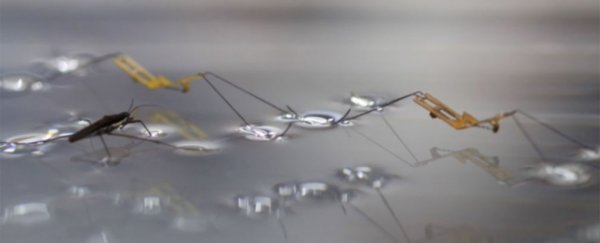As many a first-year chemistry student knows, walking on water isn't actually physically impossible; chemistry teachers often use water strider insects as an example when teaching students about the surface tension of water molecules. And now scientists have used technology to successfully mimic the bug's natural technique, developing a delicate robot that can stand on the water's surface and even jump into the air.
To create the water-jumping robot, the researchers collected natural water striders and studied video footage of the semi-aquatic insects to better understand how their movement allows them to jump off the water's surface. Trial and error with several different prototypes guided them towards a miniature machine capable of emulating the motion that water striders seem to pull off almost effortlessly.
"Water's surface needs to be pressed at the right speed for an adequate amount of time, up to a certain depth, in order to achieve jumping," the study's co-senior author, Kyu Jin Cho of Korea's Seoul National University, said in a press release. "The water strider is capable of doing all these things flawlessly."
It turns out that the key to a successful water jump lies in the legs, which in the case of the water strider feature slightly curved tips and use a rotational movement to propel the insect off the water. But the real trick is in exerting the precise degree of force required to maximise leverage from the water's surface, which amounts to a pretty unstable jumping platform when you think about it.
"Using its legs to push down on water, the natural water strider exerts the maximum amount of force just below the threshold that would break the water's surface," said Je-Sung Koh, the study's co-first author.
"This is due to their natural morphology," adds Cho. "It is a form of embodied or physical intelligence, and we can learn from this kind of physical intelligence to build robots that are similarly capable of performing extreme manoeuvres without highly-complex controls or artificial intelligence."
The team of researchers, which also included scientists from Harvard University in the US, figured out that for successful lift off, their water-jumping robot would need to be able to exert up to 16 times its own body weight on the water's surface. The robotic strider they created, reminiscent in ways of the nightmarish spider bots from the science-fiction film Minority Report, uses a "torque reversal catapult mechanism" developed by the same researchers in a prior study.
"The resulting robotic insects can achieve the same momentum and height that could be generated during a rapid jump on firm ground – but instead can do so on water – by spreading out the jumping thrust over a longer amount of time and in sustaining prolonged contact with the water's surface," said Robert Wood of Harvard University, a co–author of the study.
The research is published in Science.
